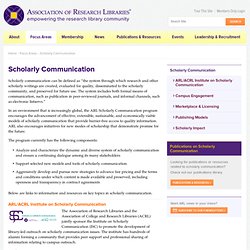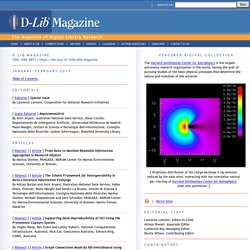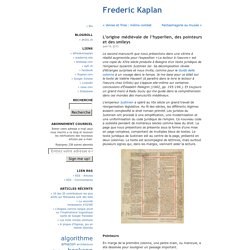

The Book as Computer - University of South Carolina. Representations, No. 42, Spring, 1993. Digital Scholarship. Association of Research Libraries. Scholarly communication can be defined as “the system through which research and other scholarly writings are created, evaluated for quality, disseminated to the scholarly community, and preserved for future use.

The system includes both formal means of communication, such as publication in peer-reviewed journals, and informal channels, such as electronic listservs.” In an environment that is increasingly global, the ARL Scholarly Communication program encourages the advancement of effective, extensible, sustainable, and economically viable models of scholarly communication that provide barrier-free access to quality information. ARL also encourages initiatives for new modes of scholarship that demonstrate promise for the future. The program currently has the following components: Below are links to information and resources on key topics in scholarly communication.
D-Lib Magazine. D - L I B M A G A Z I N E ISSN: 1082-9873 | Table of Contents [ Editorial ] Special Issue By Laurence Lannom, Corporation for National Research Initiatives [ Guest Editorial ] RepScience2016 By Amir Aryani, Australian National Data Service; Oscar Corcho, Departamento de Inteligencia Artificial, Universidad Politécnica de Madrid; Paolo Manghi, Istituto di Scienza e Tecnologie dell'Informazione, Consiglio Nazionale delle Ricerche; Jochen Schirrwagen, Bielefeld University Library [ Abstract ] [ Article ] From Data to Machine Readable Information Aggregated in Research Objects By Markus Stocker, PANGAEA, MARUM Center for Marine Environmental Sciences, University of Bremen [ Abstract ] [ Article ] Supporting Data Reproducibility at NCI Using the Provenance Capture System By Jingbo Wang, Ben Evans and Lesley Wyborn, National Computational Infrastructure, Australia; Nick Car, Geoscience Australia; Edward King, CSIRO, Australia In Brief: Short Items of Current Awareness.

Digital Libraries. L’origine médiévale de l’hyperlien, des pointeurs et des smileys. Le second manuscrit que nous présentons dans une vitrine à réalité augmentée pour l’exposition « Le lecteur à l’oeuvre » est une copie du XIVe siècle produite à Bologne d’un texte juridique de l’empereur byzantin Justinien Ier.

Sa décomposition révèle d’étranges surprises et nous invite, comme pour le Guido delle colonne à un voyage dans le temps. Je me base pour ce billet sur le texte de Valérie Hayaert (à paraitre dans le livre le lecteur à l’oeuvre chez Infolio) qui s’appuie elle-même sur certaines conclusions d’Élisabeth Pellegrin (1982, pp. 195-198.). Et toujours un grand merci à Radu Suciu qui me guide dans la compréhension dans ces mondes des manuscrits médiévaux. Lumières numériques ? entretien avec Roger Chartier. Livre au lire (Du) Fabrique des Savoirs.